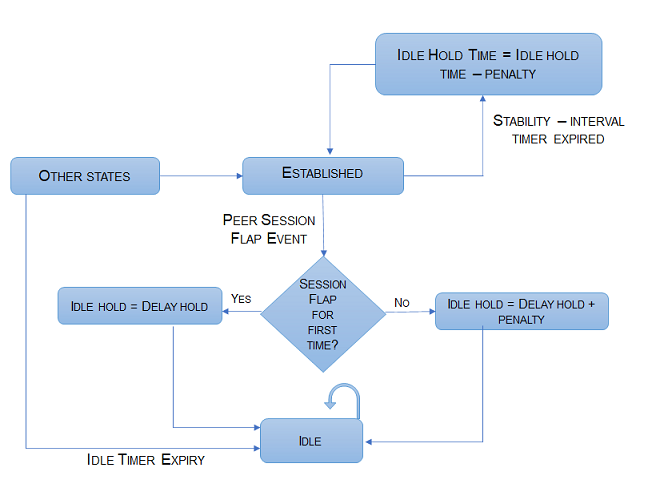Dampening BGP Peer Flap
BGP Peer Flap dampening is used to prevent unstable BGP peers from bringing down the network. Unstable peers cause a change in the routing state that requires forwarding entries to be added or removed from the forwarding table.
Adding or removing entries from the forwarding table is computationally intensive and could result in the router not being able to maintain its BGP or IBGP sessions due to it being busy. This could, sometimes, result in the router becoming unresponsive.
When a router becomes unresponsive, it can cause an increase in the network which may result in unexpected behavior and further disruptions. In some cases, it could also result in a state of stable oscillation, which has to be avoided and is harder to recover.
The optional session attribute suggested in RFC-4271-section 8.1.1, DampPeerOscillations indicates that the BGP connection is using logic that damps BGP peer oscillations in the Idle State.
How it works
A stable BGP Peer will be in the Established state. When
there is a flap in the peer session, the peer is considered to be unstable and
placed in the Idle state. Whenever the peer is placed in the
Idle state, the Idle-Hold timer is
started.
If this is the first time the peer is placed in the Idle state, the
Idle-Hold timer
is initialized with the value specified in the Delay-Hold
configuration, else, a time penalty is added to the Idle-Hold
timer. This penalty time is defined in the Penalty configuration.
For every subsequent flap, the Penalty value is added to the
Idle-Hold time till the Idle-Hold timer value
reached the value specified in the Maximum-Penalty upper limit
value. When the Idle-Hold timer reaches or exceeds the
Maximum-Penalty value, the Penalty value will
not be added to the Idle-Hold for subsequent flaps.
When the peer's status changes from Idle to
Established, the Stability-Interval timer
starts. If the BGP peer remains stable (error-free) till the expiry of the
Stability-Interval timer, the Idle-Hold timer
is reduced by the Penalty value. This is done every time the peer
is stable for the Stability-Interval period till the
Idle-Hold timer reaches zero (0).
If the value of the Idle-Hold timer is lesser than the
Penalty value, i.e., reducing the Penalty
value from the Idle-Holdvalue causes the Idle-Hold
value to go below zero (0), then the Idle-Hold value is reduced by
the value specified in the Delay-Hold value.


